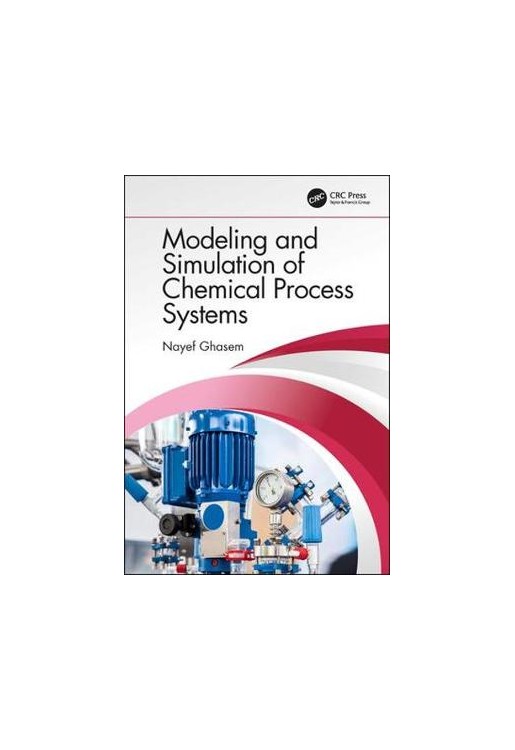This teaches how to develop mathematical model equations, solve equations manually, and compare results with software. It covers lumped parameter systems and distributed parameter systems, and uses MATLAB and Simulink. It includes chapter problems, worked examples, and summarizes reader goals at start of every chapter.
Chapter 1: Introduction
Learning objectives
1.0 Background
1.1 Mathematical models
Why studying process modeling and simulation?
1.3 Terminology of process modeling and simulation
1.3.1 State variables and state equations
1.3.2 Steady state and transient
1.3.3 Lumped versus distributed parameters
1.3.4 Model verification
1.3.5 Model validation
The Steps for building a mathematical model
Fundamental balance equations
1.5.1 Material balance
1.5.1.1 Total and Component Balances
1.5.1.2 Material balance on individual components
1.5.2 Energy balance
1.5.3 Momentum balance
1.6 Process Classification
1.6.1 Continuous processes
Batch process
Semibatch Process
Types of Balances
Procedure of mass balance
1.8.1 Microscopic balance
1.8.2 Macroscopic balance
1.9 Transport rates
1.9.1 Mass Transport
1.9.2 Momentum transport
1.9.3 Energy transport
1.9 Thermodynamic relations
1.10 Phase Equilibrium
1.10.1 Flash calculations
1.11 Chemical kinetics
Process control
1.13 Number Degree of freedom
1.14 Model solution
1.15 Model evaluation
Problems
References
Chapter 2: Lumped Parameter Systems
Learning objectives:
2.1 Introduction
2.2 Model encountered material balances only
2.2.1 Material balance without reactions
2.2.2 Material balance for chemical reactors
2.2.3 Gas phase reaction in a pressurized reactor
2.2.4 Reaction with Mass Transfer
2.3 Energy balance
Problems
References
Chapter 3: Theory and applications of distributed systems
Learning Objectives:
3.1 Introduction
3.2 Mass transport
3.2.2 Component continuity equation
3.2.2.1 Component mass continuity equation
3.2.2.2 Component molar continuity equation
3.3 Fluid dynamics
3.4 Energy transport
3.4.1 Energy transport in cartesian coordinates
3.4.2 Conversion between the coordinates
3.5 Summary of Equations of change
3.5.1 Equations of change in cartesian coordinates
3.5.2 Equations of change in Cylindrical coordinates
3.5.3 Equations of change in Spherical coordinates
3.6 Applications of the equations of change
Problems
References
Chapter 4: Computational Fluid Dynamics
Learning objectives:
4.1 Introduction
4.2 Equations of motion
4.2.1 Cartesian coordinate
4.2.2 Cylindrical coordinates
4.2.3 Spherical coordinates
4.2.4 Solving procedure
4.3 Fluid dynamic systems
4.3.1 Velocity profile in a triangular duct
4.3.2 Fluid flow in a nuzzle
4.3.3 Fluid flow past a stationary sphere
4.3.4 Incompressible fluid flows past a solid flat plate
4.4 Application to fluid dynamics
Problems
References
Chapter 5: Mass transport of distributed systems
Learning objectives.
5.1 Introduction
5.2 Diffusion of gas through membrane tube
5.3 Mass transfer with chemical reaction
5.4 Plug Flow Reactor
5.5 Diffusion of gas in solid
5.6 Diffusion with chemical reaction
5.7 Leaching of solute form solid particles
5.8 Applied examples
Problems
References
Chapter 6: Heat transfer distributed parameter systems
Learning objectives
6.1 Introduction
6.1.1 Equations of Energy
6.2 Heat Transfer from a Fin
6.3 Radial temperature gradients in an annular chemical reactor
6.4 Heat transfer in a non-Isothermal Plug-Flow reactor
6.5 Temperature profile across a composite plane wall
6.6 Applied examples
Problems
References
Chapter 7: Case Studies
Learning Objectives
7.1 Membrane reactors
Equilibrium conversion
7.1.2 Numerical solution of equilibrium conversion
7.1.3 Numerical solution in case of hydrogen permeation
7.1.4 Variable feed concentration
7.1.5 Effect of membrane thickness
References
Absorption of Carbon dioxide from flue gas
7.2.1 Capture of carbon dioxide using fresh water
7.2.1.1 Model equations
7.2.1.2 Comsol Simulation
7.2.2 Capture of using aqueous sodium hydroxide
7.2.2.1 Model equations
7.2.2.2 Comsol Simulation
References
Packed bed reactors
7.3.1 Isothermal packed bed reactor
7.3.1.1 Model development
7.3.1.2 Comsol simulation
7.3.2 Adiabatic packed bed reactor
References
7.4 Fluid flow of two immiscible liquids
7.4.1 Model development
7.4.2 Comsol Simulation
References
Production of propylene glycol in adiabatic tubular reactor
7.5.1 Model development
7.5.2 Comsol simulation
References
7.6 Coupling of fluid and heat transfer (Multiphysics)
7.7 Unsteady diffusion of contaminated source from the skin of pipe line
7.8 Maxwell-Stefan diffusion
7.8.1 Hydrogen production
References
Chapter 8: Computing Solutions of Ordinary Differential Equations
Learning objectives
8.1 Introduction
8.2 Numerical solution of single ordinary equation
8.2.1 Euler Method
8.2.2 Modified Euler's Method
8.2.3 Midpoint Method
8.2.4 Heun's Predictor Corrector Method
8.2.5 Runge-Kutta Method
8.2.5.1 Second Order Runge-Kutta
8.2.5.2 Third Order Runge-Kutta (RK3)
8.2.5.3 Fourth Order Runge-Kutta
8.3 Simultaneous Systems of first order Differential Equations
Problems
References
Chapter 9: Higher Order Differential Equations
Learning objectives
9.1 Introduction
9.2 Initial and boundary value problems
9.3 Shooting method
9.4 Simultaneous ordinary differential equation
9.5 Solving high order differential equation using Comsol
Problems
References


